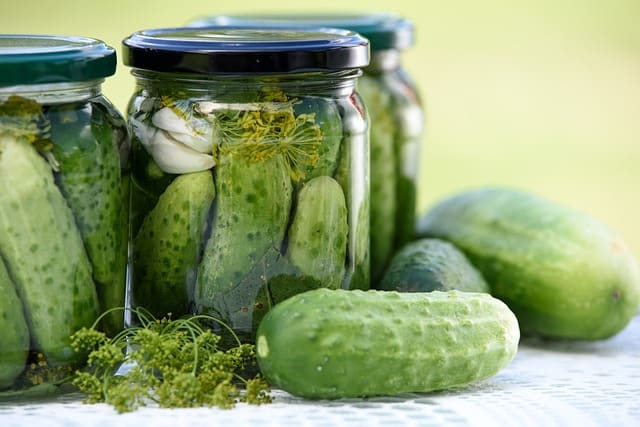You’re probably confused whenever you hear the terms “pickle juice” and “pickle brine”. Because you simply cannot find the line that distinguishes between the two.
Does it exist however?
In this article, we’ll try to find out the differences between the two terms and also learn what the basic ingredients of pickling are and their functions.

What is the difference between pickle juice and pickle brine?
There is no difference between pickle juice and pickle brine. They both make reference to the same thing which is the solution that a pickled item itself resides in. The difference here is lingual, as some prefer to call it a juice while others prefer to call it a brine.
Where did the brine come from?
From chemistry, we know that a high concentration of salt in water results in a brine which is exactly what a pickle juice is at its basic level, though the concentration of salt is a bit lower in most cases.
All other extra additions to a pickle juice during preparation are just there to affect one or two minor characteristics such as taste, flavor and color, but the most important ingredients remain salt, the natural good bacteria found on the surface of the cucumbers and then water.
The primary purpose of a pickle brine is to help preserve the fruit or vegetable (cucumber) in it for an extended duration of time, although nowadays it is no longer discarded but rather taken as a shot to relieve muscle cramps, stay hydrated and even control body sugar.
What are the ingredients in a basic Pickle brine?
The basic pickle juice contains the following ingredients:
- Salt
- Water
- Bacteria from the lactobacilli family (naturally supplied to the mixture by the cucumber)
Salt and water form the brine that helps with the preservation. Salt aids in preservation by suffocating the harmful bacteria present on the surface of the cucumber to prevent them from multiplying. When they can’t compete with the good bacteria, because salt suffocates them far less than it suffocates the bad ones, they multiply quickly, ferment the sugar in cucumber and then produce lactic acid.
The lactic acid produced then increases the acidity of the medium which suffocates the bad microbes and mould even more. Lactic acid also gives the pickle a characteristic tart flavor after some duration of storage.
In order to affect the flavor and taste of the juice, ingredients like garlic, dill and mustard seeds can be added.
Sugar can also be added for flavor and also to increase the rate at which the fermentation is happening.
One important aspect of pickling is the anaerobic conditioning: meaning that the fermentation must be done in an oxygen free environment so that the good bacteria can survive and the bad ones will suffocate.
How nutritious is a pickle Juice?
Pickle juice is packed with salt or sodium which we know has many benefits and downsides which would depend on the person consuming it and how they consume it.
The pickle juice also has many minerals in it that come from the cucumber such as potassium, calcium and magnesium. It also has probiotics that can be really beneficial to the body.
How is pickle juice made?
The process for making pickled juice using the fermentation method is pretty straight forward.
The basic ingredients you need for a 1 quart glass jar include:
- 2 tablespoons for kosher salt
- 5-7 (4-5 inch long pickle cucumber)
- Water at room temperature
All other ingredients like the fresh head of a dill, garlic, are not necessary.
Procedure
First sterilize the glass jar, seals and lids by submerging them into a water that has already been brought to a boil and keep them in there for as long as 10 minutes. Ensure to roll the jar continually in the boiling water to make sure every sides of it gets sterilized. Sterilization actually helps to eliminate any microbial life on the jar making it safe for packing the cucumbers later.
Second, add the salt to the bottom of the jar and then pack the cucumber into the jar without breaking them. First stuff the larger cucumbers into the jar and then fill up the remaining spaces with the smaller ones. Make sure the packaging is tight so no “pickle” ends up floating to the top. Now is also the time to add in other ingredients into the jar.
Afterward, fill up the jar with water and make sure to leave an half inch to an inch head space.
Wipe the rim of the jar and take out the seal from the hot water and place it over the jar rim. Close tightly with the lid and place the jar in a water bath (which is simply boiling water) for 15 minutes and then take them out. Note that the lids of the jars would turn concave after bringing them down from the water bath, and this is from the pressure built up inside the can. After about a while, the lid would then relax a bit with a popping noise and indicating that a seal has been achieved.
Place the jar in a cool dry place away from sunlight for 24 to 48 hours without touching, then go ahead and store the jar for 4 – 6 weeks first before consuming the pickle or drinking the juice.

